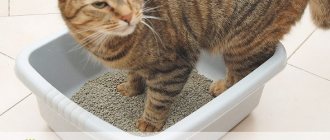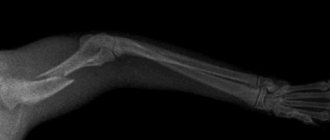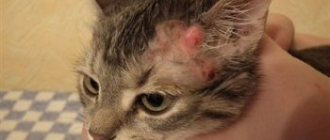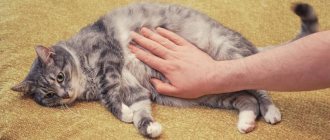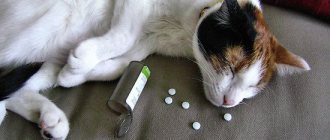Pain in cats is always difficult to diagnose. They are very good at hiding pain; often their gait practically does not change in case of any limb injuries. Therefore, it is important to understand that if you see without a special examination that a cat’s paw hurts, or is limping, or does not use it when walking, this most often indicates serious problems and very severe pain. Although there are exceptions. Some cats, on the contrary, with pain syndrome, react excessively to any touch; for example, they may not allow touching their stomach, back and paws, although only one thing hurts.
Causes and predisposition
Arthritis results from a wide variety of causes. Orthopedists say the main reason is advanced age.
. A long life leads to a decrease in the elasticity of the connective tissue and a deterioration in the motor activity of the front and hind legs. Malaise in older pets most often manifests itself in the form of dysfunction of the shoulder or elbow joints. After 10 years of life, the disease affects about 90% of cats.
Another common cause is genetics.
. This applies to breeds that are the result of unnatural selection. Modern representatives turned out to be especially predisposed to pathologies of the musculoskeletal system. Representatives of fold-eared breeds especially suffer from this problem - they are prone to hereditary anomalies in the formation of cartilage cells.
Fall from a great height
, getting hit by a car, or a fight with dogs is almost always accompanied by bruises, subluxations, sprains, and fractures. Such tissue damage to the musculoskeletal system causes inflammation and then the development of traumatic arthritis in cats.
Birth injury
also leads to deformation of the hip joint and further development of the disease. Extra pounds on a cat put no less strain on the joints: they increase friction and reduce fluid volume, which provokes connective tissue diseases.
Rheumatoid arthritis is most often caused by autoimmune diseases
. Destruction occurs due to the synthesis in the body of chemicals that destroy cartilage tissue. The disease affects almost all bones. It is sometimes caused by acromegaly, which is associated with an increase in the formation of growth hormone, which leads to irreversible processes.
Metabolic disease
causes the development of metabolic arthritis in cats. Thus, a deficiency of calcium or phosphorus, an incorrect ratio of these elements leads to disruption of the structure of bone tissue and a large number of osteochondral lesions. Another ailment - hemochromatosis (pigmentary cirrhosis) - contributes to the development of polyarthritis due to excessive accumulation of iron in the body of a pet.
Infectious strains
of various etiologies are dangerous for bones: these are viral, bacterial, fungal microorganisms. Pathogens are the main factor in the development of purulent arthritis. Polyarthritis is often caused by viral flu, calcivirus, and hepatitis.
Provoking factors include:
- incorrectly composed diet;
- weakened immune system;
- excessive physical activity;
- frequent hypothermia;
- unsanitary content.
When purchasing a pet, it is important to create all the necessary conditions to reduce the number of negative factors affecting its health.
Causes of front paw lameness
There are as many reasons as there are bones (from top to bottom: scapula, humerus, radius, ulna, metacarpus, phalanges), joints (shoulder, elbow, wrist, fingers) and paw muscles before that. As soon as one of them causes pain or discomfort, the cat will begin to limp.
- Elbow-related lameness : This is most often caused by elbow dysplasia. Sometimes there are better periods, but they never last and are always replaced by a relapse. Your veterinarian will likely refer you to a specialist who will consider surgery. Arthroscopy is often the best option because it allows the surgery to be done without widening the joint, so your cat's recovery will be shorter. A word of advice: have the surgery done by a specialist, it may be a little more expensive but you will have less risk of complications.
- Shoulder-related lameness : One of the most common causes is osteochondritis dissecans. She was diagnosed by X-ray. Arthroscopy will again be the best option as it reduces recovery time. Biceps tendinitis can also cause front leg lameness. Here, treatment will also be carried out using arthroscopy. Finally, shoulder dislocation or instability can also be mentioned. The treatment will be delicate, so it is advisable to consult a specialist.
- Lameness caused by a bone problem : A fracture is the obvious cause, in this case the cat will have little or no pressure on the broken leg. Other causes, such as panosteitis or a tumor, can also cause bone lameness.
- Lameness due to ligaments and muscles : These can be caused by an impact on a muscle or a sprain. Severe sprains are often accompanied by dislocation, so surgery to repair the ligaments should be considered. Arthrodesis, which is the fusion of the bones of the wrist, may also be necessary for a dislocated or subluxated wrist.
© shutterstock
Types of arthritis in cats
Only a veterinarian can determine the type of disease - for this he will conduct the necessary research and take tests.
Chronic progressive polyarthritis
From the name it is clear that the disease affects several organs at once, and only gets worse over time. Most often found in young males. This is called an immune-mediated condition, and veterinarians divide this condition into two phases.
In the first, most acute (progressive) phase
cartilage tissue is destroyed at the ends of the bones that make up the joint itself, as well as the processes. In parallel, thickening begins in the adjacent bones.
These disorders are similar to symptoms of hip dysplasia or similar degenerative changes. The feet, wrists, and hocks are primarily affected.
In this phase, there is an increase in body temperature, a decrease in appetite, stiffness of movement, lameness, pain, and fluid accumulation in the joints. The acute period lasts several weeks and then becomes chronic.
In the second (or chronic) phase
With progressive polyarthritis, the erosion of cartilage tissue becomes very serious: the bone under the cartilage begins to be exposed, which causes acute pain. Manifestations resemble rheumatoid diseases in humans or dogs. The process quite significantly reduces the amplitude of body movements and causes deformation due to thickening. This type usually affects young cats under 5 years of age.
There are currently no effective medications. The combination of strong painkillers and anti-inflammatory drugs does not always help. Most often, animals experience acute pain and do not respond well to drug therapy.
Calcivirus arthritis in cats
Calicivirus is a pathogenic microorganism that causes respiratory disease. Calicivirus is part of complex vaccines against plague, rhinotracheitis, and chlamydia.
Unfortunately, calicivirus can cause bone problems, leading to lameness. This condition is associated with the field or vaccine strain. Respiratory manifestations may or may not be present along with lameness. Pets with movement disorders associated with the virus often become febrile and refuse to eat.
It may stop on its own. Sometimes symptoms are treated with painkillers or anti-inflammatory drugs. Most patients make a full recovery.
Bacterial form
In pets, cartilage is susceptible to infection due to various wounds. The joint swells, becomes painful, warm to the touch, and the animal refuses to lean on the sore limb. The pet experiences a fever and loses its appetite. Sometimes the infection can reach directly to the bone - then osteomyelitis develops.
Treatment of arthritis in a cat is done by draining the fluid, rinsing it, and prescribing a course of antibiotics. Bacterial infections can cause permanent damage to the limbs, so it must be treated as soon as it is discovered.
Treatment of arthritis and arthrosis
How to treat arthritis in a cat? The first and most important rule is do not self-medicate! Therapy of joint tissue diseases requires professionalism and experience, so entrust the treatment to qualified veterinarians in Moscow.
They will determine the cause of arthritis or arthrosis, and then select effective therapy aimed at eliminating it. Additionally, maintenance treatment is prescribed using chondroprotectors and non-steroidal anti-inflammatory drugs.
In addition to drug therapy, it is important to monitor your pet’s weight. If your cat is obese, be sure to put him on a low-calorie diet. This may include:
- lean meat,
- sea fish,
- low-fat fermented milk products,
- porridge on the water,
- boiled vegetables.
Don't forget about regular checkups at the veterinary clinic!
Symptoms of arthritis in cats
Initially, changes in the structure of the cartilage do not cause pain or discomfort to the cat. Due to poorly expressed symptoms, it is difficult to quickly diagnose the pathology. Over time, movement disturbances and pain become more obvious.
Warning signs
The owner of a mustachioed friend needs to notice the first manifestations of the disease in time:
1. Decreased mobility, in which the cat tries to play less, hunt less, and refuses the usual jumping from heights. 2. An apathetic state, manifested in lethargy and fatigue. The pet spends more time lying down, sleeping, and moving little.
3. Stiff, cautious movements or unsteady gait after waking up or resting. After some time everything will return to normal.
4. The animal refuses its favorite scratching post and does not want to move along the thresholds.
5. Pays less attention to personal hygiene. The cat grooms her fur less often, licks herself, and has difficulty burying excrement in the tray.
6. Reacts poorly to touch, shows aggression when wanting to stroke a person, and does not allow himself to be held.
7. With careful palpation, you can detect swelling and compaction. Sometimes obvious thinning of the front and hind legs can be clearly seen.
8. The joints of the bones become hot, then the temperature of the whole body rises.
9. There is a persistent refusal to eat due to a sharp decrease in appetite.
According to reviews from owners, animals initially try to avoid any communication with other family members and try to hide in a secluded place.
Arthritis or arthrosis?
It is important to pay attention to the similarities between arthrosis and arthritis. In fact, arthrosis is the initial stage, as it is a destructive process that provokes inflammation. The cartilage cells around the bones wear out, they begin to directly interact with each other, and severe pain occurs.
With arthrosis there are no signs of acute inflammatory pathology. After the process of destruction has begun in the organs, it is believed that the next stage has begun. Due to the relative similarity in the clinical picture, the treatment of these pathologies does not differ too much.
Since the symptoms of both diseases are similar, self-diagnosis and self-medication should never be carried out. A doctor must determine the problem with the joints and prescribe therapy. Otherwise, the mistake threatens the animal with lameness with pain or complete immobilization.
Degrees_ that a paw bruise can take in a kitten or an adult cat
Mechanical damage to the limb such as a bruised paw in cats is divided into four degrees:
11th degree. A characteristic feature of bruises is damage to the inner layers of the skin and subcutaneous tissue. A bruise may be accompanied by the formation of a shallow wound such as an abrasion or scratch. Swelling of the injury site and pain are likely. The pain is mild and may be completely absent. Upon examination, you can notice signs of burst blood vessels on the surface of the animal’s skin. A first degree bruise is characterized by rapid healing and does not require complex treatment. Often, with a first-degree bruise, the cat does not limp. 22nd degree. Bruises of this type are accompanied by the formation of hematomas, separation and rupture of muscles. A common sign of injury is swelling caused by the inflammatory process. The animal has an elevated temperature, increased heart rate and breathing, and the cat limps for a long time. 33rd degree. Such bruises pose a real threat not only to the health, but also to the life of the cat. Third degree damage is accompanied by a change in the appearance of the skin. The concept of bruise in this case means damage to muscle tissue, tendons, the formation of fractures and cracks in bones. Along with a 3rd degree bruise, joint dislocation is often noted. When bruised, the animal experiences shock. In the absence of qualified assistance during the first day from the moment of injury, there is a risk of developing tissue necrosis. 44 degree. Mechanical damage to the limbs of the 4th degree is the most dangerous for a cat. Injuries of this complexity are accompanied by crushing of bones and crushing of tissues. Through external damage to the skin, infection enters the animal’s body. Thus, inflammatory and purulent-putrefactive processes occur. The consequence of injury is often an abscess, sepsis and associated negative processes.
Do not neglect qualified veterinary care to avoid potentially dangerous consequences. A kitten's bruised paw is an injury that requires timely attention.
How to detect a bruised paw in kittens and cats?
- The following indicate a bruised paw in a kitten or cat: symptoms:
- The appearance of swelling on the animal's paw. Swelling of the injury site is caused by internal bleeding. While the skin remains intact, blood accumulates inside, causing a characteristic swelling.
- Restless behavior of a pet. When a cat receives a mechanical injury, it feels discomfort and its behavior differs from usual. The pet looks for a “closed” place and hides from the owner, presses its injured paw, does not step on it, and often licks the limb.
- Lameness when walking. In most cases, the cat will noticeably limp due to an injured paw.
- The appearance of external signs of damage. A hematoma, bruise, or lymphatic extravasation is likely to be detected in the area of injury. These signs occur against the background of compression and shaking of internal tissues. There may be an abrasion noticeable to the naked eye, swelling due to inflammation.
In some cases, paw bruises affect internal organs
, osseous-ligamentous apparatus, which provokes the appearance of other symptoms. If you notice that the cat reacts painfully to touching the damaged paw, squeals, or “defends itself” - this is a sufficient reason to contact a veterinarian.
What to do to provide first aid when a kitten has a bruised paw?
“Street” animals accustomed to “wild” conditions can cope with minor bruises on their own
.
From this point of view, pets require more involvement from the owner. Even if we are talking about a bruise of the first and second degree, first aid is necessary before the veterinarian arrives
.
If the bruise is accompanied by bleeding , try to stop the bleeding and treat the wound. This way you will prevent infection. Be sure to wash your hands. Use gauze pads or a bandage to stop bleeding. The use of cotton wool is not recommended, as particles of the material remain in the wound and cause clogging.
If the bleeding is profuse , it is necessary to apply a special tourniquet or use improvised means. Wrap the material tightly around the edge of the damaged vessel or pinch it with your finger wrapped in a handkerchief. Hold your finger on the wound until a blood clot appears, blocking the bleeding. The artery on the hind leg is pinched from the inside of the thigh, and on the front leg – “above the elbow”.
Be sure to treat the wound to prevent infection. Any disinfectant composition is suitable for this, including hydrogen peroxide or brilliant green. After stopping the bleeding and treating the wound, fix the paw and provide the animal with rest.
These actions are enough to provide first aid to the animal. Next, the owner should immediately contact our veterinary center. Our veterinarians will undertake the diagnosis and determine further treatment to avoid the negative consequences of the bruise.
Diagnosis of the disease
To prescribe adequate treatment, your veterinarian will need to find out the history of arthritis in your cat. This will help to understand the clinical picture and correctly identify the disease and its subtype. Before visiting the clinic, prepare answers to frequently asked questions:
1. What type of movement restrictions did the animal begin with? Did they start suddenly or did it take some time? How long does it last? Are there any signs of deterioration?
2. Which limbs are suspicious? Are there other unrelated symptoms? What's your appetite?
3. Does the animal participate in shows or breeding?
4. When were the last injuries? What diseases did you have? Have you come into contact with carriers or patients?
5. What types of vaccines were used and when? Is he taking medications? What kind of nutrition does he receive?
6. Did your parents have pathologies of muscles, nerves, bones?
If the cat is in obvious pain, the doctor will use an anesthetic to make the examination more comfortable.
Diagnosis begins with a radiograph or x-ray, which will help assess the damage and determine a treatment regimen. The processes in the damaged organ can be very small, so x-rays are taken from all sides at different angles. Usually other procedures, such as ultrasound, MRI or CT, are done to get a more complete picture.
Blood is taken for a complete analysis. Different cell types are being studied. The result will tell your veterinarian what could be causing the lameness. Serological tests are used - these are tests that are carried out for various immune pathologies or bacteria. For example, they may detect Lyme disease or rheumatoid inflammation.
If the doctor sees swelling, he places a thin needle into it and collects synovial fluid, which is then carefully examined. The test accurately determines the presence of infection, impaired immunity, or injury. For a bacterial infection, the type of strain is determined, which is important for prescribing a course of antibiotics.
But sometimes even these tests are not enough to make a definitive diagnosis. In this case, a biopsy is performed: a small piece of tissue lining the organ is removed and then examined. This type of analysis is especially useful for detecting cancer.
The biopsy is performed using arthroscopy, which means inserting an endoscope through a tiny incision. Such gentle examination is increasingly used in veterinary medicine. Using an arthroscope, the doctor can examine the inside and take material for analysis.
In rare cases, arthrotomy (exposure of the area) is used in small individuals whose limbs are too small for such an examination. During arthrotomy, the organ should be examined, a biopsy taken, and, if necessary, the connective cartilage should be restored.
How to treat arthritis in cats?
Treatment of arthritis in cats can only be prescribed by a specialist after a careful examination of the patient and careful study of the results of laboratory tests. The owner should know that restoring the normal functioning of diseased organs will require a lot of time and effort.
This is a labor-intensive process, mostly aimed at relieving pain and stopping the destruction of cartilage tissue. Unfortunately, it will not be possible to completely get rid of a serious illness, but you can help the animal.
Drug therapy
Drug treatment for arthritis in cats consists mainly of combining different types of medications.
1. Hormone therapy
, which allows you to quickly stop the spread of swelling. Hormonal drugs have a good effect on stopping pain, but have a number of serious side effects, so the veterinarian prescribes them with great caution. The most popular medications are prednisolone, dexamethasone, and hydrocortisone.
2. Anti-inflammatory tablets
non-steroidal drugs that have a pronounced analgesic effect. The choice for mustachioed friends is very limited, due to individual characteristics and the risk of side effects. The drugs in this series include meloxicam, ketoprofen, tolfedine, carprofen, robenacoxib.
3. Analgesics
opioids can be used instead of non-steroidal drugs. These are human medications that have narcotic components, so they can only be dispensed with a prescription from a veterinarian. The most popular are tramadol, gabapentin, buprenorphine, amantadine.
4. Warming ointments or gels
are rarely prescribed due to the risk of getting into the patient's stomach when licked. There is no point in purchasing these drugs when treating an infectious form, as well as during the acute phase.
5. Chondroprotectors
with active chondroitin and glucosamine help only stop degenerative destruction, and not eliminate it entirely. However, the use of the medicine gives good results, so this type of medicine is also part of the regimen. The main drugs in the series are artroglycan, chondrolone, chondartron, chondroitin.
6. Antibiotics
are widely used during the suspension of the infectious form of the disease. They can only be prescribed by a veterinarian; no self-medication is allowed. It is best if the appointment occurs after receiving information about the composition of the intercartilaginous fluid. Such an analysis will determine how the body will react to a specific drug from a given series.
7. Physiotherapy
makes the suffering pet's condition normal. Light massages can only be used during remission. They are strictly contraindicated for severe pain during an exacerbation.
8. Internal injections
, or blockade of nerve endings with novocaine. A complex and responsible procedure can only be carried out by a doctor, otherwise it will cause much more harm than good.
9. Surgical intervention
It is carried out only in extreme, very advanced cases. We are talking about amputation of a damaged limb. Corrective surgeries or prosthetics are rarely practiced. In case of infection, the limb is docked to prevent it from spreading throughout the body.
10. Vitamin and mineral complexes
used as maintenance therapy. They use vitamins E and C, which can help stop the destruction of cartilage and fight inflammation.
Tinctures, homeopathic medicines or acupuncture have no effect on the disease, since they simply cannot interrupt the destructive process. You shouldn’t waste money on them, and most importantly, time. Only an experienced doctor, based on tests and examination, is able to make a decision on effective care for a pet.
A special remedy recommended for treatment and prevention is freely sold in veterinary pharmacies. Indeed, this is one of the safest medications, but it is not a panacea. No one guarantees that after a course of use, a mustachioed pet will completely recover or never get sick.
Physiotherapy
Often, a veterinarian will prescribe a massage for a furry patient, which can be done at home. It includes not only gentle massage of the limbs, but also stretching exercises. Physiotherapeutic procedures can be carried out only in the remission stage, but not during the acute phase.
If your cat (this is rare) likes to swim, your veterinarian will advise giving her baths more often. If the animal is afraid of water, then swimming procedures will do harm, not good.
Surgical intervention
In especially severe cases, surgery has to be performed. Indications for intervention include ruptures of compounds, complete thinning of tissues, and complex cases of dysplasia. Sometimes the cat is given a prosthetic or protective plate.
In modern veterinary medicine, it is customary to postpone surgery for the most severe forms of the disease, and cope with milder forms using a set of various measures. If the owner follows all the doctors' recommendations, feeds the pet correctly and cares for it, surgical intervention will not be required.
Patient care
An extremely unpleasant ailment, which causes not only pain, but also great inconvenience to the cat, requires increased attention from the owner and all family members. In addition to medications, the patient must be provided with comfortable living conditions and maximum care.
Arrangement of resting and feeding areas
You should start with a bed, which should be medium soft and quite spacious. The sleeping place should not be placed at a height, as the patient risks falling and receiving additional injuries. The best place for placement is the floor. However, you need to place the bed so that the cat is warm and there are no drafts below.
Bowls with food and water are placed near the crib. This is also done for the safety of the patient. You need to buy a tray with low walls so that you don’t have to lift up the highly injured legs. The filler used is small, it is poured in a thin layer. Then the cat will be able to fit comfortably in it.
Some felines like to sleep at heights. This is extremely dangerous, so it is worth blocking the path to the closet, window or refrigerator with boxes so that your mustachioed friend cannot jump into his usual place. Due to the constraint of movements, it is difficult for the pet to practice hygiene, so you need to comb the cat at least 2 times a week and trim the tips of the claws.
Painful sensations do not allow the mustachioed friend to enjoy communication with the owner. Indeed, the manifestation of affection in the form of hugs, throwing up, lifting by the paws is now under the strictest prohibition. Active games, fun and pranks with the patient are also prohibited.
Diet as the key to joint health
In addition to the measures listed, it is important to adhere to a special diet. This is especially necessary for individuals who are obese. Typically, the veterinarian recommends special medicinal industrial wet or dry food of premium class and higher, or natural, complete food with low calorie content. The menu should include:
- lean meats: chicken fillet, turkey, veal, beef, rabbit;
- sea, lean fish with a small number of bones;
- fermented milk products with low fat content or completely fat-free;
- boiled, chopped vegetables;
- cereals cooked in the form of porridge in water;
- cartilage, fresh gelatin broths.
You cannot offer cats food from the owner's table, tubular bones, sweets, salty or smoked foods, or milk.

